Easy One-Pan French Onion Soup Chicken: A Weeknight Bistro Delight
Imagine the warm, inviting aroma of classic French onion soup – those deeply caramelized, golden-brown onions, the rich, savory broth, and a luxurious blanket of melted, bubbly Gruyère cheese. Now, picture all that incredible flavor infused into tender, juicy chicken, made simply in a single pan for an effortless weeknight dinner. This is the magic of French Onion Soup Chicken. It’s a comfort food masterpiece that delivers all the sophisticated taste of a French bistro without the fuss, perfect for when you crave something special but need it to be easy. Forget packets and cans; this recipe uses fresh, wholesome ingredients to create an unforgettable, from-scratch meal that comes together surprisingly quickly.

The inspiration for this delightful French Onion Chicken recipe comes from a cherished memory of cooking for private clients. I often prepared a classic French chicken dish featuring beautifully caramelized onions and a touch of crème fraîche. That elegant, yet comforting, meal sparked the idea to translate those beloved French bistro flavors into a simplified, one-pan chicken dinner. The result is a dish that captures the essence of sophisticated French cuisine – tender chicken, wonderfully sweet caramelized onions, a deeply flavored savory broth, and perfectly melted cheese – all achievable in about 45 minutes. It’s the kind of meal that feels luxurious but is surprisingly approachable, making it a perfect addition to your weekly rotation.
Why You’ll Love This French Onion Soup Chicken Recipe
This French Onion Soup Chicken isn’t just another dinner recipe; it’s an experience. Here’s why it’s sure to become a new favorite:
- Unmistakable Classic French Onion Flavor: We’re talking about those essential elements – the irresistible sweetness of perfectly caramelized onions, a rich and deeply savory broth, and a generous layer of gooey, melted cheese. This recipe masterfully reinterprets these iconic flavors into a hearty and satisfying chicken dinner. It’s comfort food at its finest, but with an elevated, gourmet touch.
- Wholesome, From-Scratch Goodness: Say goodbye to processed packets and canned ingredients. This recipe prides itself on using simple, fresh ingredients that you likely already have in your pantry. Building flavor from the ground up ensures a superior taste and a healthier meal, giving you complete control over what goes into your food.
- Perfect for Weeknights (and Weekends!): Designed with busy schedules in mind, this recipe is incredibly weeknight-friendly. Boneless, skinless chicken breasts cook quickly, while the onions, though they require a bit of patience, do most of the heavy lifting in terms of flavor development. The one-pan approach minimizes cleanup, making it an ideal choice for busy evenings. Yet, its impressive flavor also makes it suitable for entertaining guests or enjoying on a relaxed weekend.
- Effortlessly Elegant: While simple to prepare, the end result looks and tastes like something you’d order at a high-end restaurant. The golden chicken, the rich onion sauce, and the bubbling cheese make for a visually appealing dish that’s sure to impress anyone at your table.
- Comfort in Every Bite: There’s something inherently comforting about the flavors of French onion soup. Transformed into a chicken dish, it offers that same cozy, soul-warming sensation, perfect for chilly evenings or any time you need a little culinary hug.
Once you fall in love with this chicken dish, you might also want to try my recipe for easy French Onion Soup to experience the classic in its original form!
Essential Ingredients for French Onion Chicken
Crafting this flavorful French onion chicken relies on a handful of quality ingredients that work in harmony to create its signature taste. Here’s a closer look at what you’ll need and why each component is crucial:

- Boneless, Skinless Chicken Breasts: These are the star protein, prized for their lean texture and quick cooking time. For even cooking, especially if breasts are very large, I recommend cutting them horizontally to create thinner cutlets. This prevents dry edges and ensures every bite is tender and juicy.
- Olive Oil: Essential for searing the chicken to a beautiful golden brown and contributing to the initial sauté of the onions. Opt for a good quality extra virgin olive oil for best flavor.
- Unsalted Butter: Combined with olive oil, butter adds a rich, nuanced depth to the caramelized onions, enhancing their sweetness and creating that classic bistro flavor profile. Unsalted butter allows you to control the overall saltiness of the dish.
- Onions: The absolute heart of this dish. Slow caramelization transforms humble onions into a sweet, jammy, and intensely flavorful base. The type of onion matters here; see the chef’s tip below for guidance. They contribute bulk and the signature “soup” element.
- Garlic Cloves: Finely chopped or grated, fresh garlic adds a pungent, aromatic layer that complements the sweetness of the caramelized onions, building a more complex flavor profile for the sauce.
- Broth: This is what deglazes the pan, capturing all those delicious browned bits (fond) and forming the savory sauce. Beef broth is my top recommendation, as it provides the deepest, most authentic French onion soup flavor. However, high-quality chicken broth can also be used for a slightly lighter, yet still delicious, result.
- Dry White Wine (Optional, but Recommended): A splash of dry white wine (like Sauvignon Blanc or Pinot Grigio) is used for deglazing. It adds a sophisticated layer of acidity and fruitiness, deepening the overall flavor of the sauce. If you prefer to skip alcohol, simply use extra broth.
- Bread: Toasted slices of French bread or baguette serve as the traditional “croutons” for scooping up the rich sauce and onions. Their crispy texture provides a delightful contrast to the tender chicken.
- Cheese: The crowning glory! Gruyère is the classic choice for French onion soup, known for its nutty flavor and superb melting qualities. Other excellent melting cheeses include Comté, Beaufort, or a good quality Emmental (Swiss). Their robust flavors hold up beautifully against the rich onions and broth.
- Fresh Herbs: A sprinkle of fresh chopped parsley for garnish adds brightness and a pop of color. For an extra authentic French bistro note, consider adding fresh tarragon, which has a subtle anise-like flavor that pairs wonderfully with chicken and onions.
Remember to refer to the recipe card for precise measurements of all ingredients, including salt and pepper, which are crucial for seasoning.
Chef’s Tip: Choosing the Best Onions for French Onion Chicken
Sweet onions (like Vidalia or Walla Walla) are my absolute top recommendation for this dish. Their naturally higher sugar content means they caramelize more quickly and develop an incredible, deeply sweet flavor once cooked down. Yellow or brown onions are also excellent choices; they start with a sharper flavor but mellow beautifully and sweeten significantly during the long cooking process. For the best color and flavor, I suggest you steer clear of red onions for this particular recipe, as their color tends to turn muddy, and their flavor profile isn’t quite the right match for the delicate balance of a classic French onion dish.
If you’re a true enthusiast of caramelized onions and their inherent sweetness, you might also enjoy these oven roasted red onions with balsamic. They make a fantastic side dish for a juicy steak or a perfectly roasted chicken.
Creative Substitutions and Delicious Variations
While this French Onion Soup Chicken recipe is perfect as written, it’s also incredibly versatile. Feel free to experiment with these thoughtful substitutions and variations to tailor it to your taste or what you have on hand:
- Chicken Thighs for Added Flavor and Moisture: If you prefer dark meat, boneless, skinless chicken thighs are an excellent substitute for breasts. They offer even more flavor and tend to stay exceptionally juicy. When using thighs, you can skip the pounding step as they are naturally thinner and more uniform. Adjust the cooking time slightly, adding about 3-4 minutes extra to ensure they reach a safe internal temperature of 165°F (74°C). If using bone-in, skin-on thighs, brown them skin-side down first for extra crispiness, then proceed with the recipe, allowing an additional 10-15 minutes of covered cooking until they reach 165°F.
- Bread Options for Cheesy Croutons: The cheesy croutons are a must for the full French onion experience! For those with dietary restrictions, simply use your preferred gluten-free baguette or French bread variety. You can also use other crusty breads like sourdough or ciabatta for a different texture.
- Fresh Chopped Thyme Leaves: For an earthy, aromatic note that complements the rich onions and chicken, sprinkle a teaspoon or two of fresh chopped thyme leaves into the pan with the onions as they caramelize. Its subtle flavor adds another layer of French authenticity.
- Mushrooms: Sauté sliced mushrooms (cremini or shiitake work well) with the onions to add more umami depth and texture to the dish.
- Creamy Finish: For an even richer, creamier sauce, stir in 1-2 tablespoons of crème fraîche or heavy cream at the very end, just before serving. This adds a luxurious consistency without overpowering the classic flavors.
- Different Cheeses: While Gruyère is traditional, don’t hesitate to use other good melting cheeses you enjoy. Provolone, mozzarella, or even a sharp cheddar can offer a delicious twist, though the flavor profile will be slightly different from the classic.
- Vegetarian Option: While this is a chicken dish, the onion sauce is so flavorful, you could adapt it for vegetarians by swapping chicken for large, thick slices of roasted portobello mushrooms or seared firm tofu, adjusting cooking times accordingly.
Mastering Caramelized Onions: Tips & Tricks for Perfect Flavor
Caramelized onions are more than just an ingredient in French Onion Soup Chicken; they are the very soul of its flavor. This process, while simple, often trips up home cooks who are either impatient or unsure of what to look for. Rushing the caramelization is the fastest way to end up with onions that are either burnt and bitter or pale and lacking depth. The secret, as with many great culinary techniques, lies in a combination of patience, gentle heat, and using the right equipment. Get these three elements right, and you’ll be rewarded with gorgeously jammy, deeply golden onions that transform this chicken dish from good to extraordinary. Here’s how to achieve perfect caramelized onions every single time:
- Make Ahead for Convenience: Caramelized onions are incredibly versatile and can be prepared 2-3 days in advance. Cook them fully, then store them in an airtight container in the refrigerator until you’re ready to use them. This makes weeknight cooking even faster!
- Choose the Right Onion Variety: As mentioned, sweet onions (like Vidalia or Walla Walla) are ideal because their naturally higher sugar content allows them to brown faster and taste incredibly delicious once caramelized. Yellow or brown onions also work wonderfully and develop a rich, mellow sweetness, though they may take a few minutes longer. Avoid red onions, as their color can turn unappetizingly muddy, and their flavor isn’t quite right for this specific application.
- Slice Evenly and Consistently: Uniformity is key here. Thin slices (⅛” to ¼” thick) that are all roughly the same size will cook at the same rate, preventing some pieces from burning while others remain undercooked. Use a sharp knife or a mandoline for precision.
- Utilize a Wide Skillet or Pan: A wide surface area is crucial. This allows the onions to spread out in a single layer, ensuring they sauté and brown rather than steam. When onions are crowded, they release too much moisture and steam, making it difficult for them to caramelize properly. A 12-inch skillet or braiser is usually perfect.
- Cook Low and Slow: This is the golden rule of caramelization. Keep the heat at medium-low and be patient. Stir the onions frequently (every few minutes) to prevent sticking and ensure even browning. The process typically takes 20-25 minutes, but sometimes longer depending on the onion type and heat. Don’t be tempted to crank up the heat; slow cooking develops deep, complex sweetness without bitterness.
- Deglaze as Necessary: If the onions start to stick to the bottom of the pan or develop overly dark spots, don’t panic! Add a small splash of water or broth (a tablespoon or two) to the pan. Use a wooden spoon to scrape up any browned bits (this is called “fond,” and it’s pure flavor!). Continue cooking and stirring. This technique helps keep the onions from burning and incorporates all that concentrated flavor into the sauce.
- Skip the Added Sugar: With patience and the right type of onions, there’s absolutely no need to add sugar for sweetness. The natural sugars within the onions themselves will develop and intensify beautifully as they caramelize, creating an authentic, rich flavor.
Chef’s Tip – The Art of Pounding Chicken Breasts for Even Cooking
Have you ever noticed that one end of a chicken breast is significantly thicker than the other? This natural unevenness is a common culprit for dry, overcooked edges and undercooked centers. The solution is simple: gently pounding the thickest part of the chicken breast. You don’t need to flatten it completely into a thin cutlet; the goal is simply to create a more uniform thickness across the entire breast. A few light taps with a meat mallet or even a rolling pin will do the trick. By doing this, you ensure that the chicken cooks more evenly from edge to edge, resulting in perfectly juicy, tender chicken every single time, without any dry or tough spots. This small step makes a huge difference in the final texture of your dish.
Step-by-Step: Crafting Your Easy French Onion Chicken
Creating this delicious French onion chicken is a straightforward process, especially when you follow these steps. For the best results and efficient cooking, I highly recommend using a wide, heavy-bottomed pan, ideally 12 inches across. A generous surface area ensures that your onions caramelize beautifully rather than steam, and your chicken cooks evenly. I personally love my 3½-quart Le Creuset braiser with a glass lid for this recipe; it’s a fantastic value and one of my most used pieces of cookware. If you don’t have one, any heavy skillet or sauté pan that’s wide enough for the onions to spread out comfortably will work perfectly.
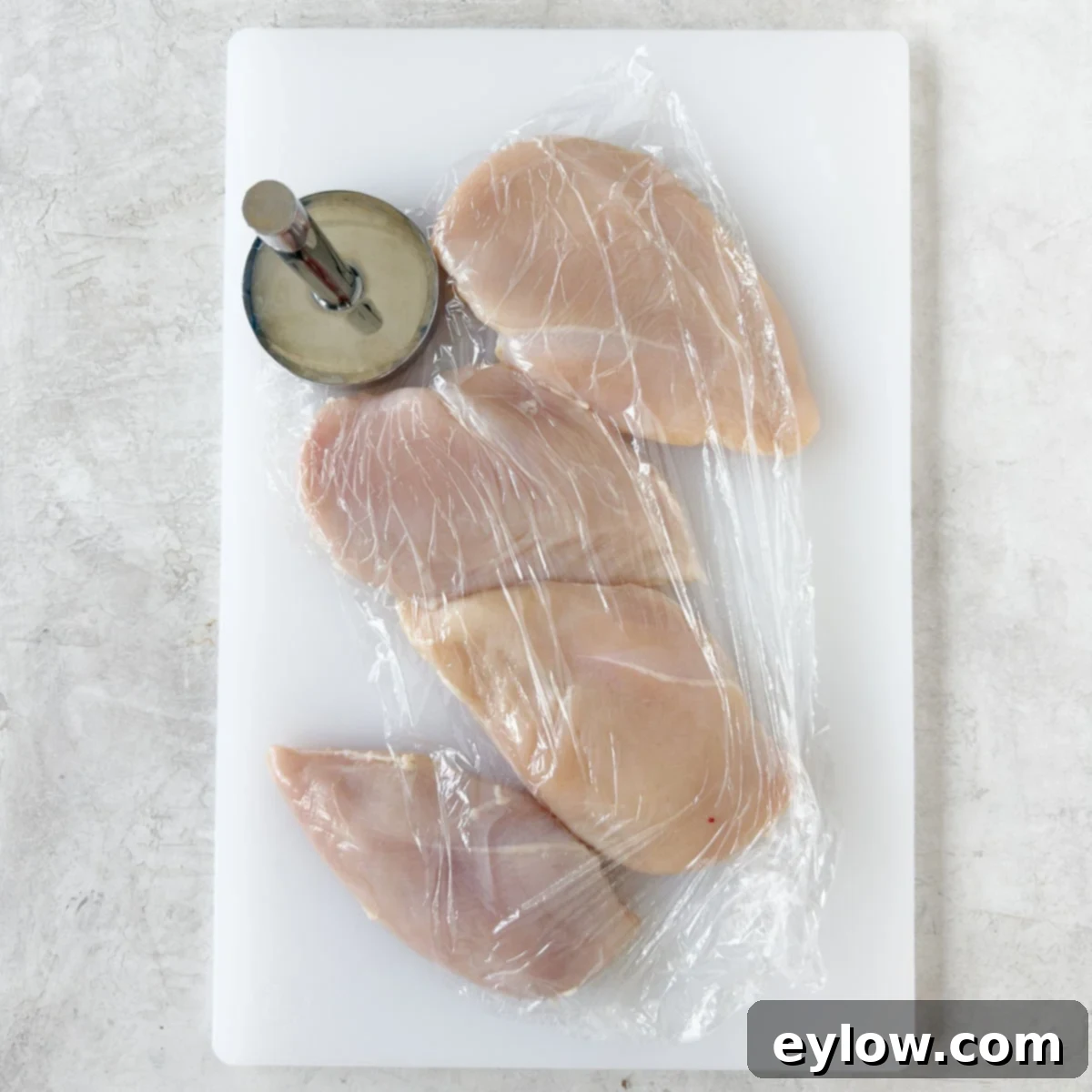
- **Prepare the Chicken:** Lay your boneless, skinless chicken breasts on a cutting board and cover them with a layer of plastic wrap. Gently pound the thicker ends of the chicken until they achieve a more even thickness. This crucial step promotes uniform cooking, preventing one end from drying out while the other cooks through.
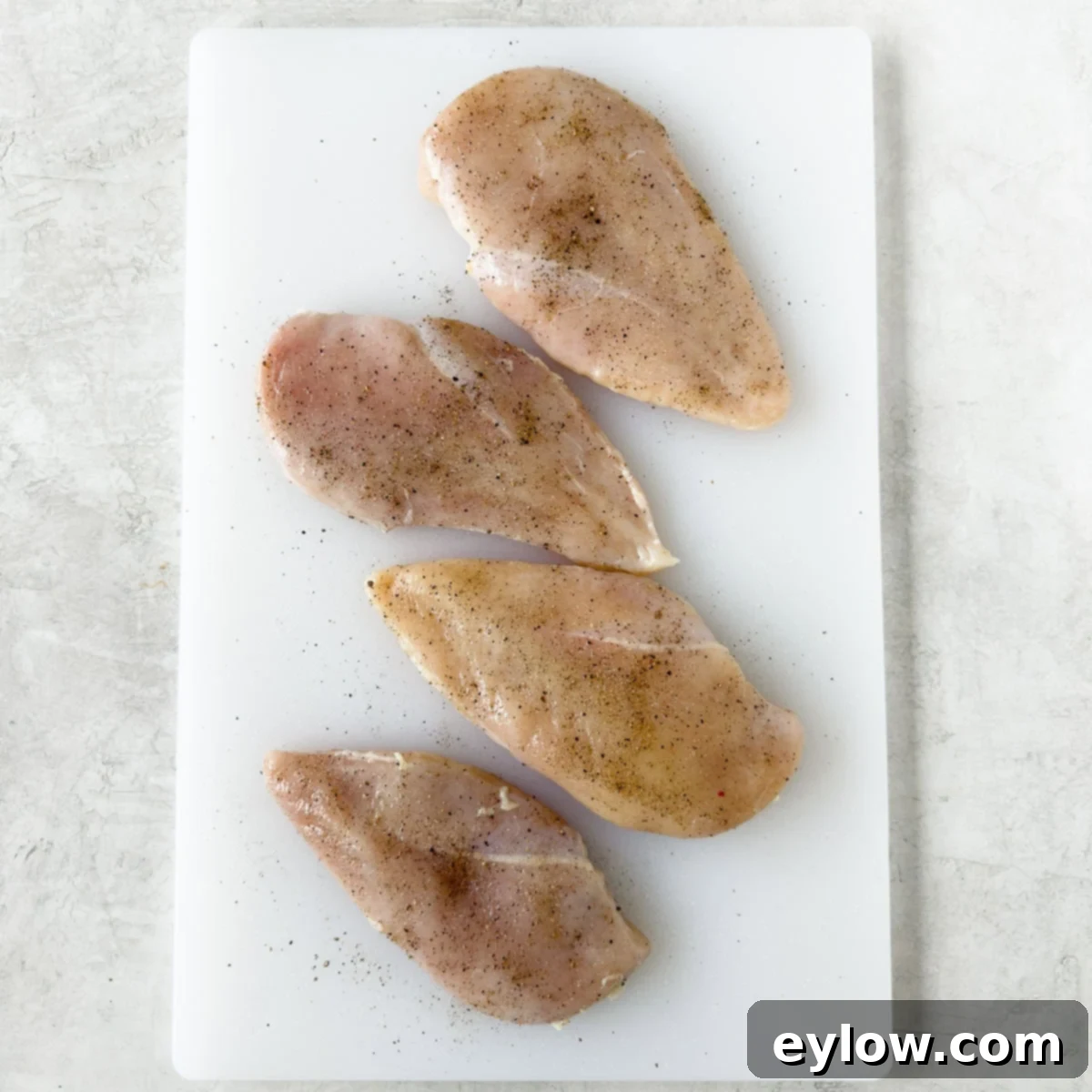
- **Season the Chicken:** Generously season both sides of the prepared chicken breasts with salt and freshly ground black pepper. Don’t be shy with the seasoning, as it forms the initial flavor layer.
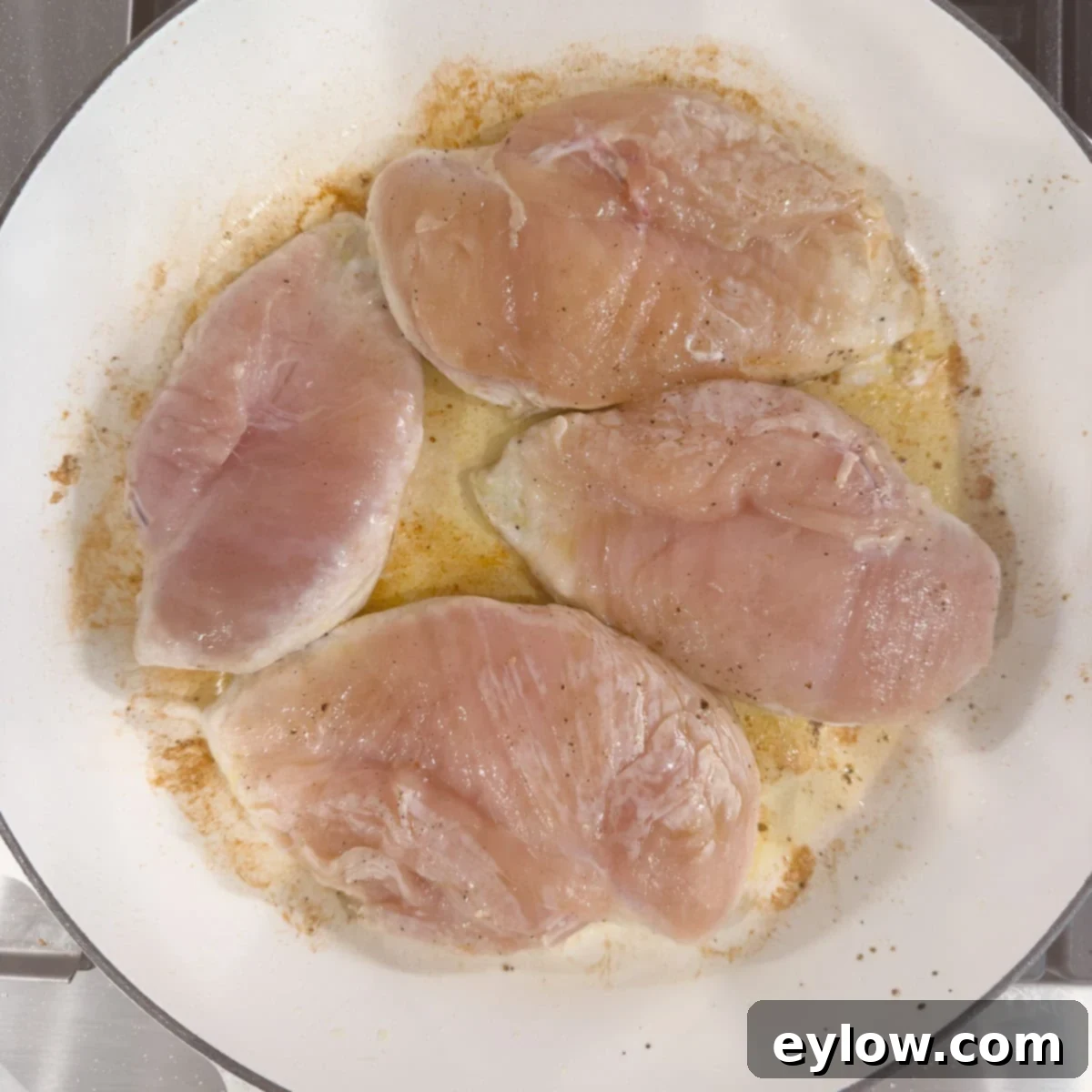
- **Sear the Chicken:** Heat the olive oil in your wide 12-inch pan over medium heat until shimmering. Carefully add the seasoned chicken breasts, top-side down, into the hot oil. Cook undisturbed for 6-8 minutes until they develop a beautiful golden-brown crust. This searing creates a flavorful fond at the bottom of the pan, which will later enrich your sauce. Do not turn and cook the other side yet.
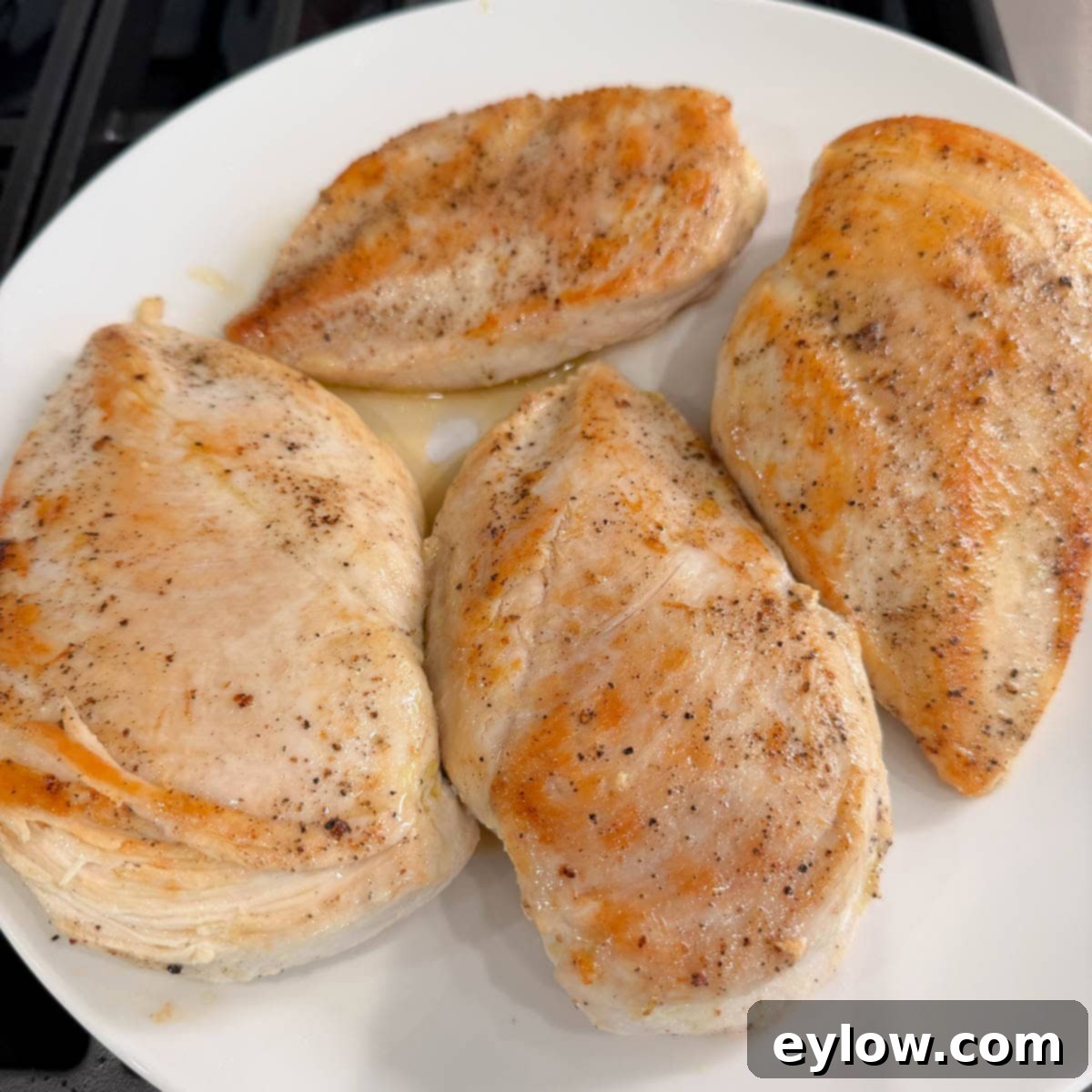
- **Rest the Chicken:** Once seared, carefully remove the chicken breasts from the pan and transfer them to a plate. Loosely cover them with aluminum foil or a lid to keep them warm while you prepare the onions. This resting period also allows the juices to redistribute, ensuring tender chicken.

- **Slice the Onions:** Halve the medium onions, then lay them flat on your cutting board. Using a sharp knife, slice them into thin, uniform pieces, about ⅛” to ¼” thick. Consistent slices are key for even caramelization.

- **Begin Caramelizing the Onions:** Reduce the heat in the same pan to medium-low. Add the unsalted butter and let it melt. Once melted, add all the sliced onions to the pan. Season with a pinch of salt to help draw out moisture. Stir frequently and patiently cook the onions for approximately 20-25 minutes. This slow process is essential for developing their deep, sweet, and jammy texture. Adjust the heat as needed to prevent burning; never leave the stove unattended during this crucial step.

7. After about 10 minutes, your onions will begin to soften and take on a light golden color. Continue to stir them occasionally, ensuring even cooking and preventing any sticking.
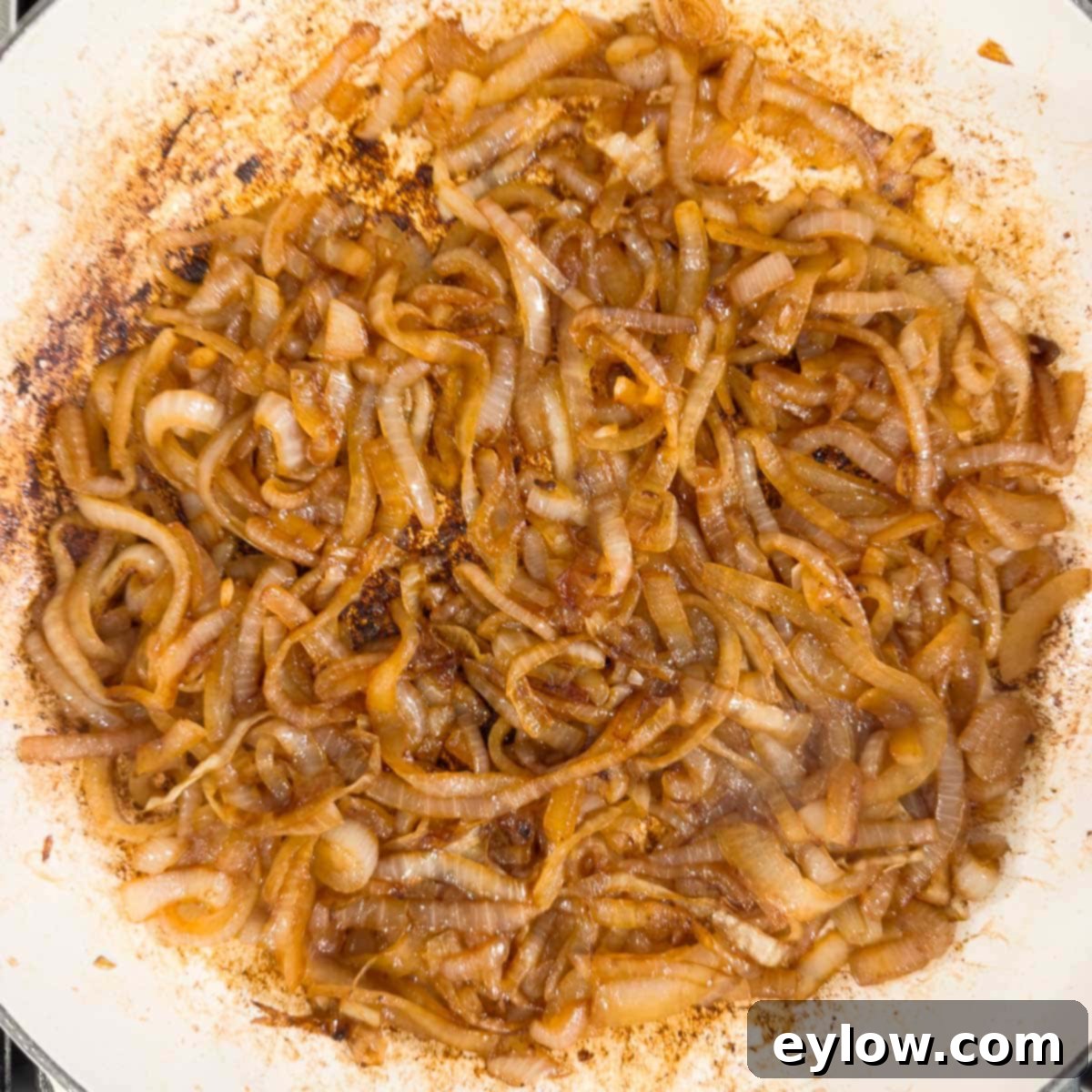
8. Continue cooking for a total of 20-22 minutes until the onions are a deep, rich golden brown and have a jammy consistency. At this point, add the finely chopped garlic and Worcestershire sauce to the pan, stirring constantly for just one more minute until fragrant. This ensures the garlic doesn’t burn.
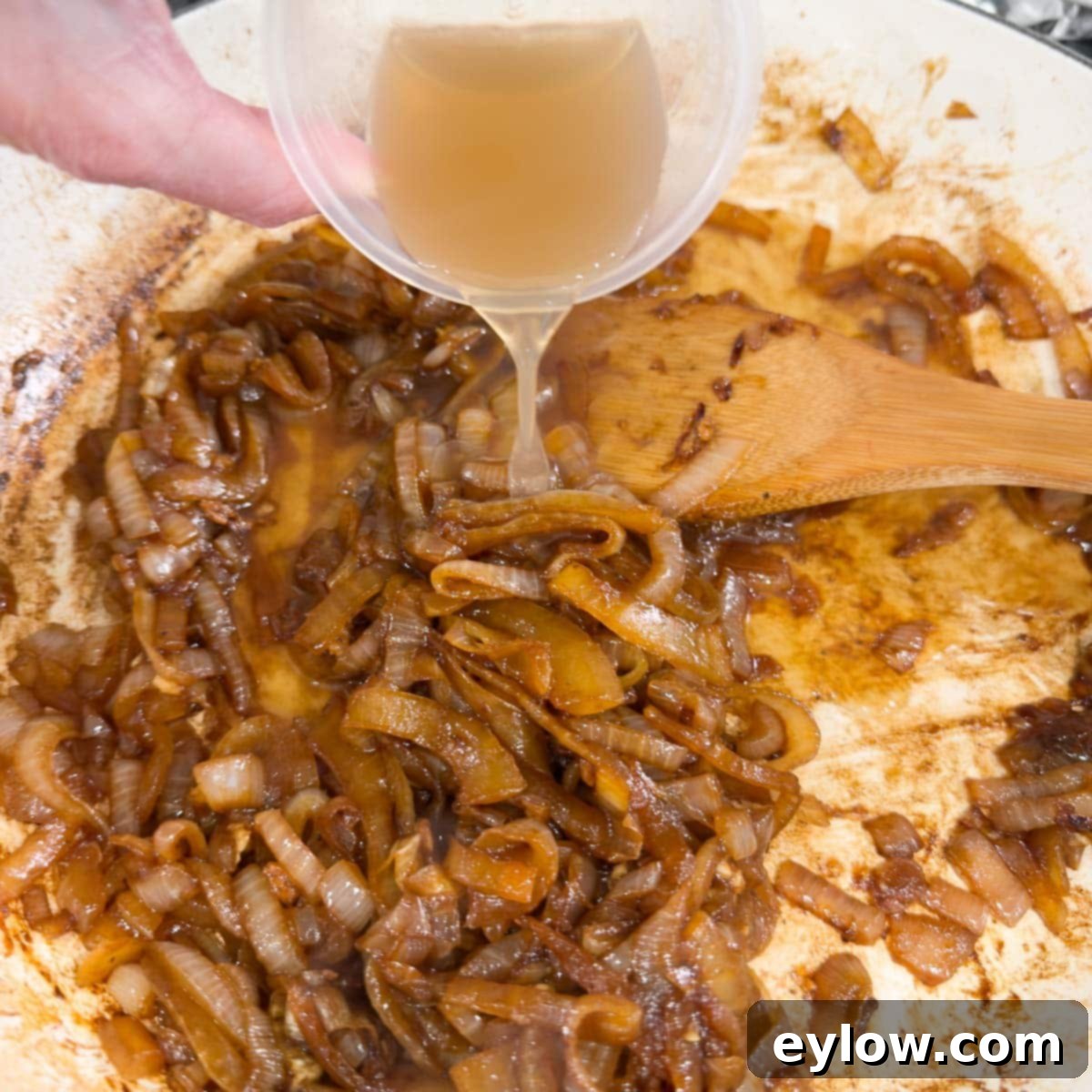
9. Pour the dry white wine into the pan, scraping up any browned bits (fond) from the bottom with a wooden spoon – this is deglazing, and it adds immense flavor to your sauce. Stir until the wine has almost completely evaporated. Then, add the beef broth, stirring it into the onions. Bring to a gentle simmer and let it cook for 1-2 minutes until the sauce begins to slightly thicken. This forms the luscious “soup” base for your chicken.

- **Finish Cooking the Chicken:** Gently nestle the seared chicken breasts back into the pan, submerging them slightly in the onion sauce. Cover the pan with a lid and continue to cook over medium-low heat for 8-10 minutes, or until the thickest part of the chicken reaches an internal temperature of 160°F (71°C) when checked with an instant-read thermometer. Remove the pan from the heat; the residual heat will carry over the cooking to 165°F (74°C), ensuring juicy, perfectly cooked chicken.

- **Prepare the Cheesy Croutons:** While the chicken finishes cooking, prepare your cheesy croutons. In a small bowl, combine melted butter, olive oil, and a pinch of garlic powder. Brush this fragrant mixture generously over slices of French bread or baguette.

- **Toast the Cheesy Croutons:** Top the buttered bread slices with a few tablespoons of your chosen cheese (Gruyère or Parmesan). Place them on a baking sheet and broil for 1-3 minutes, or toast them in a toaster oven, until the cheese is beautifully melted, bubbly, and slightly golden. Watch carefully to prevent burning!
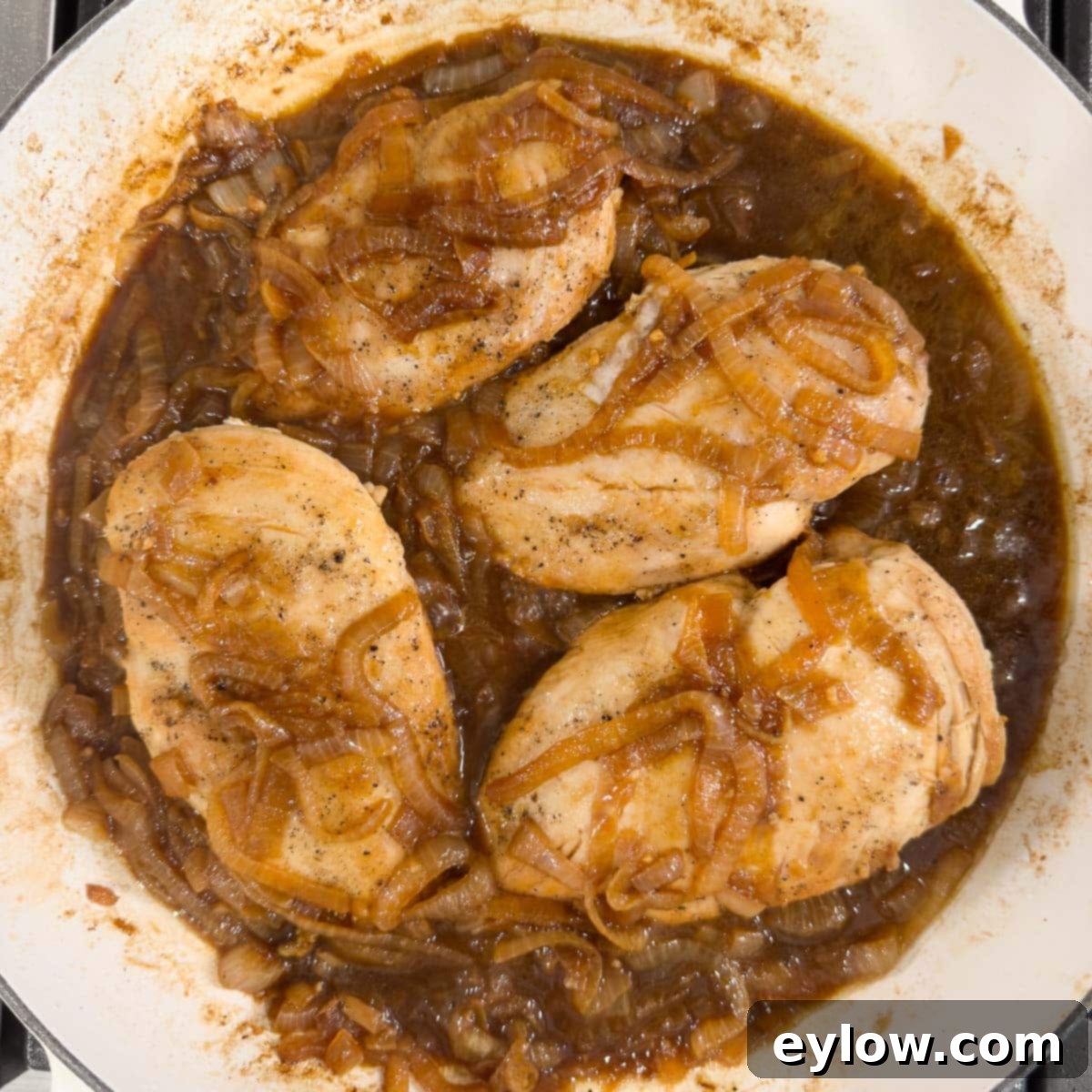
Chef’s Tip: Crafting the Perfect Cheesy Croutons
For years, my go-to cheesy croutons have featured Parmesan cheese, which melts into an irresistibly salty, golden crust – truly addictive! For this French Onion Soup Chicken, I leaned into the authentic French onion vibe by using Gruyère on the chicken itself and often on the croutons too. However, you absolutely can use Parmesan on your croutons (or a delightful mix of both Gruyère and Parmesan!) and save the Gruyère exclusively for the chicken in the pan. To achieve maximum flavor and an incredible golden crunch, remember to generously brush your bread slices with a delectable blend of melted butter, a touch of olive oil, and a pinch of garlic powder before they hit the broiler or toaster. This small step ensures your croutons are flavorful throughout, not just on top!
Delicious Serving Suggestions
This French Onion Soup Chicken is a complete meal on its own, but pairing it with the right side dishes can elevate your dining experience even further. Here are some delightful serving suggestions:
- Creamy Mashed Potatoes or Cauliflower Mash: The ultimate comfort pairing! Both mashed potatoes and cauliflower mash provide a soft, creamy base that’s perfect for soaking up every last drop of the rich, savory onion sauce. They make the meal heartier and incredibly satisfying.
- Buttered Noodles or Rice: For a simple yet effective side that truly turns this into a substantial and hearty meal, serve the chicken and sauce over a bed of buttery egg noodles or fluffy white rice. These neutral bases absorb the incredible flavors of the dish beautifully.
- Fresh Green Vegetable: To balance the richness of the dish, a bright and crisp green vegetable is a perfect accompaniment. Consider quick and easy options like simple green beans sautéed with a little garlic, steamed broccoli, or asparagus. Their freshness cuts through the savory flavors.
- Light Green Salad: A crisp green salad, tossed with a tangy quick homemade French Vinaigrette, provides a refreshing contrast. The acidity of the vinaigrette helps cleanse the palate and brightens the entire meal.
- Extra Crusty Bread: Beyond the cheesy croutons, having some plain, crusty bread on the side is always a good idea for soaking up any remaining sauce – because no drop of that deliciousness should go to waste!
- Wine Pairing: A dry white wine like Sauvignon Blanc or Pinot Grigio that was used in the recipe, or a light-to-medium-bodied red like Pinot Noir, would complement the rich flavors beautifully.
Storing and Freezing French Onion Chicken
One of the beauties of this French Onion Soup Chicken is that it tastes just as wonderful, if not better, the next day! Here’s how to properly store any leftovers and even freeze portions for future enjoyment:
Refrigerate: To keep your leftovers fresh and flavorful, transfer any cooled French Onion Soup Chicken (both the chicken and the onion sauce) to an airtight container. It will store beautifully in the refrigerator for up to 3 days. When ready to reheat, gently warm it on the stovetop over medium-low heat, stirring occasionally, until it’s heated through. Be careful not to overheat the chicken, as this can make it dry.
Freeze: This dish is surprisingly freezer-friendly, making it an excellent option for meal prepping. The cooked chicken and the rich onion sauce freeze well together for up to 2 months. To freeze, allow the chicken and sauce to cool completely before transferring them to a freezer-safe airtight container or heavy-duty freezer bags. When you’re ready to enjoy, thaw the frozen contents overnight in the refrigerator. Reheat gently on the stove over low to medium heat until warmed through. For the best culinary experience, I highly recommend making fresh cheesy croutons just before serving, as previously frozen bread tends to lose its desirable crispy texture.
French Onion Chicken: Your Questions Answered
Here are some frequently asked questions to help you master this delicious French Onion Soup Chicken recipe:
Absolutely! Boneless, skinless chicken thighs are a fantastic alternative. They tend to stay extra juicy and boast a richer flavor. When using thighs, you can skip the pounding step as they are naturally thinner and more uniform in thickness. Expect the cook time to be approximately 3-4 minutes longer than breasts, but always rely on an instant-read thermometer to ensure they reach an internal temperature of 165°F (74°C).
Yes, partially! The most time-consuming part, caramelizing the onions, can be done up to 2-3 days in advance. Store them in an airtight container in the refrigerator. When you’re ready to cook, simply reheat the caramelized onions in your pan. If they seem a bit dry, add a splash of broth to make them saucy again. Then, proceed with cooking and finishing the chicken in the pan, ensuring it’s covered to heat thoroughly to 165°F (74°C). For an extra touch of richness when making ahead, you could stir in a tablespoon or two of crème fraîche with the broth.
Beef broth is traditionally used in French onion soup and will yield the deepest, most authentic, and robust French onion soup flavor for this dish. Its rich, savory notes perfectly complement the caramelized onions and cheese. Chicken broth, on the other hand, offers a lighter, slightly milder result. While still incredibly delicious, it won’t have the same profound depth as beef broth. Use chicken broth if you prefer a lighter profile or if that’s what you readily have available in your pantry.
No, you absolutely do not need to add extra sugar to caramelize onions successfully. The natural sugars within the onions themselves are more than sufficient. Especially if you choose sweet onion varieties like Vidalias, their higher sugar content helps them brown beautifully and intensely sweeten as they cook. Even with yellow or brown onions, patience is the only key ingredient required. Give them enough time to slowly cook over low to medium-low heat, and they will naturally transform into a rich, jammy, and wonderfully sweet base for your dish, without any added sweeteners.
For deglazing, a dry white wine is ideal. Sauvignon Blanc, Pinot Grigio, or even an unoaked Chardonnay work wonderfully. Choose a wine you enjoy drinking, as its flavor will be concentrated in the sauce. If you prefer not to use wine, simply substitute with an equal amount of beef or chicken broth.
Yes, this recipe can easily be made gluten-free. The main components (chicken, onions, broth, cheese) are naturally gluten-free. The only element you need to adjust is the bread for the cheesy croutons. Simply use your favorite gluten-free baguette or crusty bread, and the rest of the recipe remains the same!
The most common reasons for poor caramelization are rushing the process or overcrowding the pan. Ensure your heat is truly set to medium-low, and give the onions the full 20-25 minutes (or more) they need. If the pan is too crowded, the onions will steam instead of brown. Use a wide enough skillet to allow them to spread out. If they start to stick, a splash of water or broth will help deglaze the pan and prevent burning.
📖 Recipe
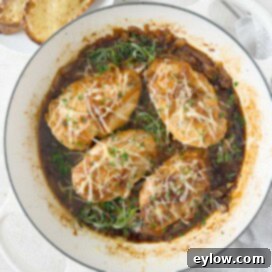
French Onion Soup Chicken
Sally Cameron
Pin Recipe
Equipment
-
Large cast iron or enamel cast iron skillet with lid 12″
Ingredients
- 1 ½ – 2 pounds boneless skinless chicken breasts
- ¾ teaspoon salt
- ¼ teaspoon black pepper
- 1 tablespoon extra virgin olive oil
- 2 medium onions about 1 ¾ pounds, 5 cups sliced
- 1 tablespoon unsalted butter
- 3 tablespoons dry white wine
- 2 large garlic cloves finely chopped or zested
- 1 teaspoon Worcestershire sauce
- ¾ cup low sodium beef broth
- ½ cup grated Gruyère cheese or Comté or Swiss
- 1-2 teaspoons chopped fresh parsley optional garnish
- 1-2 teaspoons chopped fresh tarragon optional garnish
For the Cheesy Croutons
- 1 tablespoon melted butter
- 1 tablespoon extra virgin olive oil
- 1 pinch garlic powder
- ¼ cup grated Gruyère cheese
- ¼ cup grated Parmesan cheese (optional)
Instructions
Prepare & Brown the Chicken
-
Place chicken breasts on a cutting board, cover with plastic film, and gently pound the thicker ends until the breasts are of a more even thickness. Season generously with salt and pepper.
-
Heat olive oil in a large 12-inch skillet or 3 ½ quart braiser over medium heat. Place chicken top-side down and sear until golden brown, about 6-8 minutes. Do not flip. Transfer the chicken to a plate and cover loosely to keep warm.
Caramelize the Onions
-
Reduce heat to medium-low. Add butter to the pan. Once melted, add the sliced onions and a pinch of salt. Cook slowly, stirring frequently for 20-25 minutes, until onions are deep golden brown and jammy. Adjust heat as needed to prevent burning. Add garlic and Worcestershire sauce during the last minute of cooking, stirring until fragrant.
Build the Sauce & Finish Chicken
-
Pour in the dry white wine and deglaze the pan, scraping up all the browned bits from the bottom. Cook until the wine is almost gone. Stir in the beef broth and simmer for 2 minutes to slightly reduce and thicken.
Nestle the browned chicken back into the onion sauce. Cover the pan and cook over medium-low heat for 8-10 minutes, or until the thickest part of the chicken reaches 160°F (71°C). Remove from heat; carryover cooking will bring it to 165°F (74°C).
Prepare Cheesy Croutons
-
While the chicken is finishing, combine melted butter, olive oil, and garlic powder. Brush this mixture onto bread slices. Top with your grated cheese (Gruyère or Parmesan) and broil or toast until bubbly and golden.
To Serve
-
In the last minutes of the chicken cooking, sprinkle the remaining grated cheese over the chicken and onion mixture in the pan, then cover with the lid to allow it to melt into a luscious topping.
Serve the chicken directly from the pan, generously spooning the caramelized onions and rich sauce over each piece. Garnish with fresh chopped parsley or tarragon for a vibrant finish. Serve with the warm, cheesy croutons on the side – they’re perfect for dipping and soaking up all the delicious French onion flavors!
Notes
